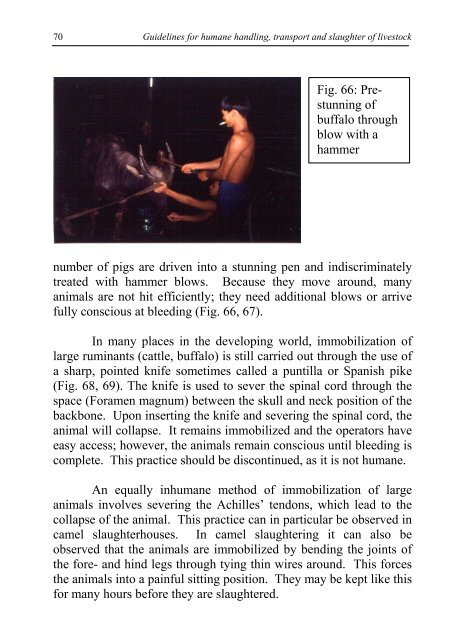Guidelines for humane handling, transport and slaughter of
Guidelines for humane handling, transport and slaughter of
Guidelines for humane handling, transport and slaughter of
Create successful ePaper yourself
Turn your PDF publications into a flip-book with our unique Google optimized e-Paper software.
70<br />
<strong>Guidelines</strong> <strong>for</strong> <strong>humane</strong> <strong>h<strong>and</strong>ling</strong>, <strong>transport</strong> <strong>and</strong> <strong>slaughter</strong> <strong>of</strong> livestock<br />
Fig. 66: Prestunning<br />
<strong>of</strong><br />
buffalo through<br />
blow with a<br />
hammer<br />
number <strong>of</strong> pigs are driven into a stunning pen <strong>and</strong> indiscriminately<br />
treated with hammer blows. Because they move around, many<br />
animals are not hit efficiently; they need additional blows or arrive<br />
fully conscious at bleeding (Fig. 66, 67).<br />
In many places in the developing world, immobilization <strong>of</strong><br />
large ruminants (cattle, buffalo) is still carried out through the use <strong>of</strong><br />
a sharp, pointed knife sometimes called a puntilla or Spanish pike<br />
(Fig. 68, 69). The knife is used to sever the spinal cord through the<br />
space (Foramen magnum) between the skull <strong>and</strong> neck position <strong>of</strong> the<br />
backbone. Upon inserting the knife <strong>and</strong> severing the spinal cord, the<br />
animal will collapse. It remains immobilized <strong>and</strong> the operators have<br />
easy access; however, the animals remain conscious until bleeding is<br />
complete. This practice should be discontinued, as it is not <strong>humane</strong>.<br />
An equally in<strong>humane</strong> method <strong>of</strong> immobilization <strong>of</strong> large<br />
animals involves severing the Achilles’ tendons, which lead to the<br />
collapse <strong>of</strong> the animal. This practice can in particular be observed in<br />
camel <strong>slaughter</strong>houses. In camel <strong>slaughter</strong>ing it can also be<br />
observed that the animals are immobilized by bending the joints <strong>of</strong><br />
the <strong>for</strong>e- <strong>and</strong> hind legs through tying thin wires around. This <strong>for</strong>ces<br />
the animals into a painful sitting position. They may be kept like this<br />
<strong>for</strong> many hours be<strong>for</strong>e they are <strong>slaughter</strong>ed.
















